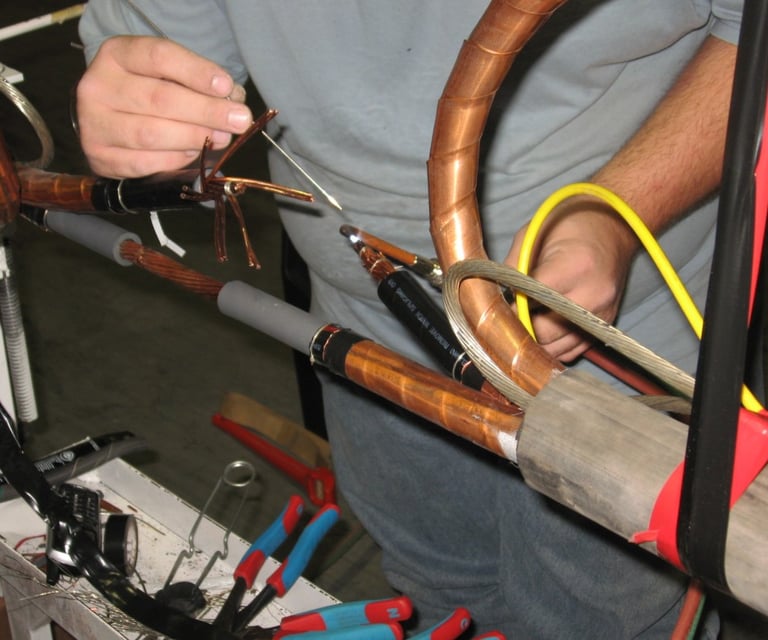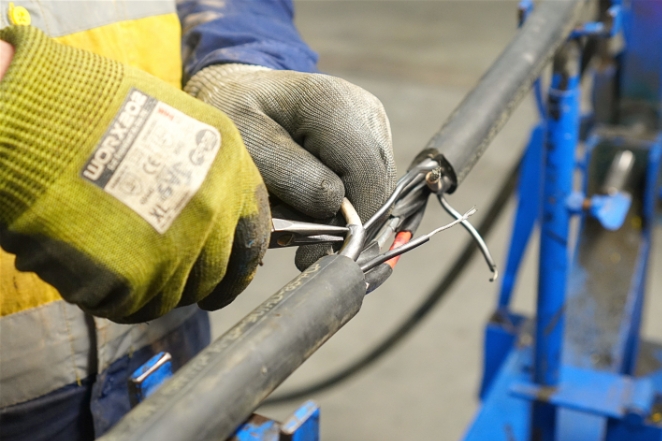Anhui Feichun Special Cable Co.,Ltd Li.wang@feichuncables.com
Can You Splice Mining Cables? What Are the Risks?
Splicing mining cables is common in South African operations for repairs and installations. But is it safe? Learn about the risks, best practices, and SANS 1520-1 compliance.
Li.wang@Feichun Cable
7/21/20255 min read


In South Africa’s mining industry—one of the most critical sectors of the national economy—mining cables are lifelines. These heavy-duty cables are responsible for transmitting power, signals, and data through some of the harshest conditions imaginable: underground tunnels, wet environments, extreme heat, and corrosive substances. Over time, even the most durable mining cables suffer wear and tear. Whether due to accidental cuts, environmental degradation, or length adjustments during operational shifts, repairs become inevitable.
Cable splicing—the process of joining two ends of a cable—offers a solution. It's often necessary to restore or extend cable functionality without replacing the entire length. However, splicing is not as straightforward as it seems, especially in the dangerous environment of South African mines. Poorly executed splicing can result in electrical failure, regulatory breaches, or even fatal accidents.
This article explores what mining cable splicing entails, the challenges it faces in South African mining contexts, associated risks, and best practices for maintaining both functionality and safety. We also answer frequently asked questions (FAQs) and highlight recent local incidents to illustrate the consequences of improper splicing.
What Is Mining Cable Splicing?
Cable splicing refers to the process of physically joining the ends of two cables to form a continuous electrical connection. In the mining sector, this practice is critical in multiple contexts:
Restoring Damaged Cables: Accidental mechanical damage or insulation breakdown can interrupt operations. Splicing can restore functionality without full replacement.
Length Adjustments: When operations expand deeper into underground shafts or across wider open-cast sites, additional cable length may be required.
Re-routing Power: Operational changes might necessitate cable movement or redirection, which can require cutting and splicing.
Common Splicing Materials and Tools
Typical mining cable splicing requires:
Heat-shrink or cold-shrink splice kits
High-voltage-rated insulation materials
Mechanical or compression connectors
Waterproof sealing compounds
Flame-retardant wrapping
Protective sheaths or armouring
Personal Protective Equipment (PPE)
These components must be compatible with the type of mining cable being repaired (e.g., SANS Type 41, 61A, 611, or Type 63), and conform to local standards like SANS 1520-1 and NRCS regulations.
Challenges of Splicing in Harsh Mining Environments
South African mining environments—such as the platinum belt of Rustenburg or the goldfields around Carletonville—pose unique challenges to safe and effective cable splicing.
Moisture and Water Ingress
Many underground mines experience high humidity and water seepage. Without proper sealing, moisture can infiltrate the splice, causing insulation breakdown, corrosion of conductors, and eventual failure.
Mechanical Stress
Cables in draglines, shuttle cars, and reeling systems experience constant bending, pulling, and impact. A splice that isn’t properly reinforced may crack or break under such strain.
Chemical Exposure
Chemical residues from ore processing or acidic mine water can degrade cable insulation. In areas like Mpumalanga coal mines, acidic conditions are common, making splicing integrity critical.
Fire and Explosion Risks
In confined spaces like underground shafts, poor splicing can lead to arcing, which in turn may ignite combustible gases such as methane—a real danger in areas like the Free State gold mines.
Case in Point:
In 2023, a fire outbreak in a shaft near Welkom was traced back to a poorly insulated splice that had become soaked in brine-rich water. The resulting short circuit sparked a fire that halted operations for 72 hours.
Risks Associated with Improper Splicing
Despite being a common practice, cable splicing done incorrectly or under unsuitable conditions introduces serious risks:
Electrical Failures
Splicing errors can lead to:
Inconsistent voltage transfer
High contact resistance
Hot spots
Voltage arcing
These faults may not be immediately apparent, but over time can cause catastrophic cable failures.
Safety Hazards
Improper splicing can expose workers to live conductors or cause unexpected equipment shutdowns, which are particularly dangerous in automated or mechanised environments.
Reduced Cable Lifespan
A poorly executed splice creates a weak point. It may compromise the integrity of the entire cable run, necessitating premature replacement and raising operational costs.
Regulatory Non-compliance
Non-compliance with South African standards like SANS 1520-1 or failure to follow NRCS directives can result in fines, permit suspensions, or liability in the event of workplace accidents.
Best Practices for Safe and Compliant Splicing
To minimise the risks associated with mining cable splicing, the following best practices are essential:
Use Certified Splice Kits
Only use splice kits rated for the cable voltage and application. For example, Type 61A 0.64/1.1kV cables require low-voltage-certified materials, while Type 63 cables demand high-voltage-rated insulation.
Ensure Complete Sealing
Use heat-shrink sleeves or resin compounds to fully seal the splice against water and contaminants. In high-moisture mines, consider double sealing or using gel-filled barriers.
Engage Qualified Personnel
Only trained and certified technicians should perform splicing. They must understand:
Cable types (shielded, unshielded, concentric)
Voltage classification
Insulation coordination
Fault current capacity
Comply with South African Standards
Follow SANS 1520-1 specifications for splicing practices, materials, and testing. All installations must be NRCS-approved to legally operate in South Africa.
When Splicing Should Be Avoided
There are situations where splicing is not just risky—it’s outright unsafe or non-compliant:
High-Voltage Zones: For cables above 11kV, splicing is rarely recommended due to insulation complexity and explosion risks.
Mission-Critical Segments: Cables powering life-support systems or ventilation in underground mines should be replaced, not spliced.
Severe Mechanical Damage: If cable armour, shielding, and core are compromised, the cable may need full replacement.
Manufacturer Prohibitions: Some cable types (e.g., pre-terminated fibre or smart cables with embedded sensors) should not be spliced under any circumstances.
Frequently Asked Questions (FAQs)
Q1: Can I splice a mining cable myself if I have a splice kit?
A: No. Mining cable splicing must be performed by qualified electricians or technicians with knowledge of local standards and the specific cable type.
Q2: Is splicing legal under South African mining regulations?
A: Yes, but it must comply with SANS 1520-1 and be inspected as per NRCS requirements. Unauthorized splicing can lead to shutdowns or legal action.
Q3: How long does a splice last?
A: If done correctly with proper materials, a splice can last years. However, harsh mining conditions may shorten this lifespan.
Q4: Can you splice fibre-optic mining cables?
A: Yes, but it requires specialised fusion splicing equipment and should only be done in clean, controlled environments.
Q5: Are there alternatives to splicing?
A: In some cases, modular cable systems or junction boxes can eliminate the need for direct splicing. Replacement may also be more cost-effective for critical segments.
Splicing mining cables in South Africa is both a necessity and a risk. It is an integral part of operations in underground platinum shafts, open-pit coal mines, and deep-level goldfields. When performed correctly—with proper materials, trained personnel, and adherence to local standards like SANS 1520-1—splicing can restore cable function effectively and safely.
However, when done carelessly, it introduces significant hazards: from cable failure and fire to regulatory breaches and worker injuries. As mines become increasingly automated and dependent on uninterrupted power and data flow, the stakes have never been higher.
Mining companies must invest in the right tools, training, and inspection regimes to ensure that every splice is not just a connection—but a secure link in the chain of mining success.



Email Address: Li.wang@feichuncables.com
© 2025. All rights reserved.


One-click to Quickly Contact
Products
Offshore & Marine Cable
XLPE Cable
Contact
Company
Location:
Building A Private Science and Technology Park, Hefei Economic and Technological Development Zone, Anhui Province, China
